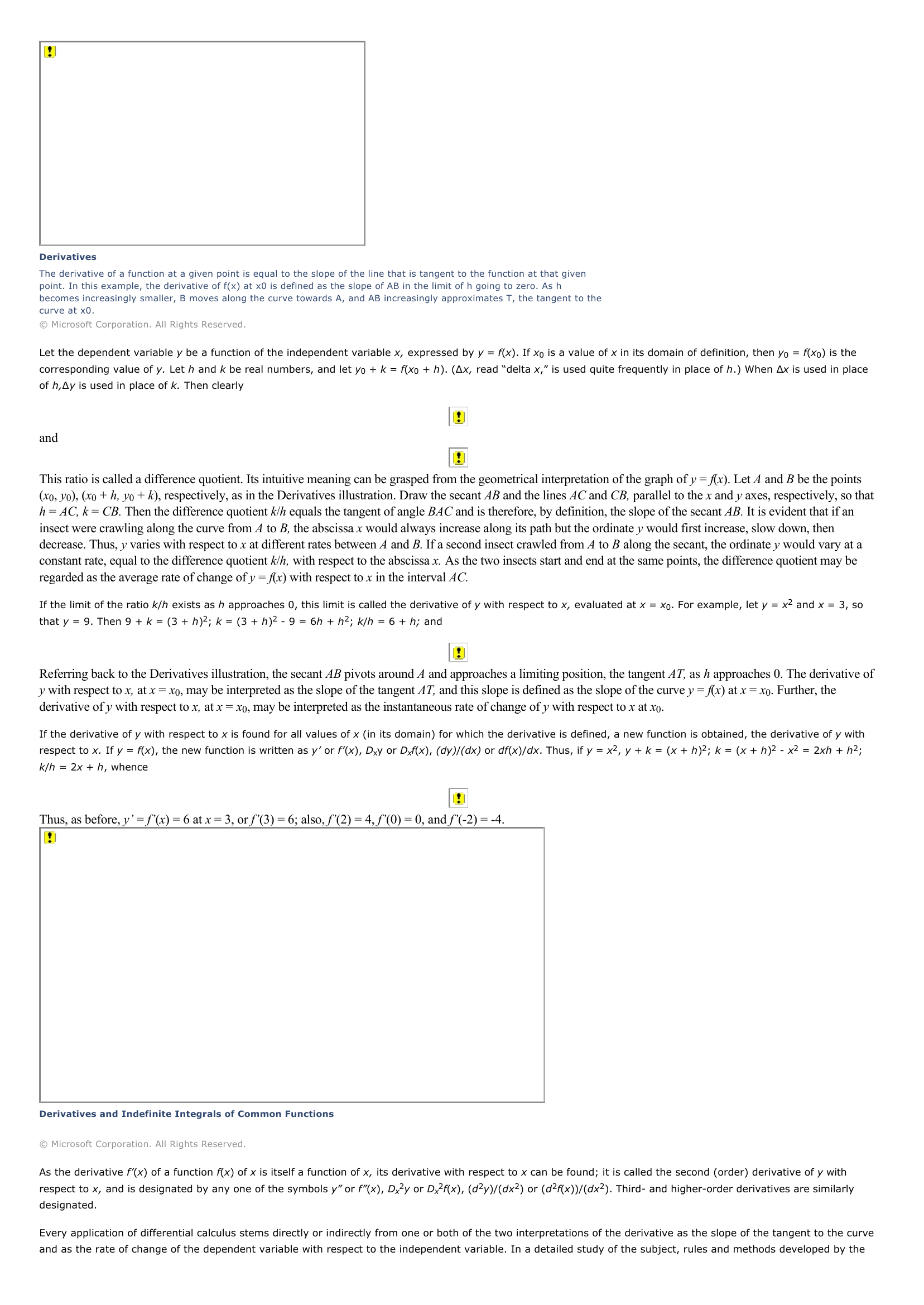Calculus (mathematics) I INTRODUCTION Limits This graph, which charts the function f(x)=1x, shows that the value of the function approaches zero as x becomes larger and larger.
Publié le 12/05/2013

Extrait du document
«
DerivativesThe derivative of a function at a given point is equal to the slope of the line that is tangent to the function at that givenpoint.
In this example, the derivative of f(x) at x0 is defined as the slope of AB in the limit of h going to zero.
As hbecomes increasingly smaller, B moves along the curve towards A, and AB increasingly approximates T, the tangent to thecurve at x0.© Microsoft Corporation.
All Rights Reserved.
Let the dependent variable y be a function of the independent variable x, expressed by y = f(x).
If x0 is a value of x in its domain of definition, then y0 = f(x0) is the corresponding value of y.
Let h and k be real numbers, and let y0 + k = f(x0 + h).
(Δ x, read “delta x,” is used quite frequently in place of h.) When Δ x is used in place of h,Δy is used in place of k.
Then clearly
and
This ratio is called a difference quotient.
Its intuitive meaning can be grasped from the geometrical interpretation of the graph of y = f(x).
Let A and B be the points (x0, y0), (x0 + h, y0 + k), respectively, as in the Derivatives illustration.
Draw the secant AB and the lines AC and CB, parallel to the x and y axes, respectively, so that h = AC, k = CB.
Then the difference quotient k/h equals the tangent of angle BAC and is therefore, by definition, the slope of the secant AB.
It is evident that if an insect were crawling along the curve from A to B, the abscissa x would always increase along its path but the ordinate y would first increase, slow down, then decrease.
Thus, y varies with respect to x at different rates between A and B.
If a second insect crawled from A to B along the secant, the ordinate y would vary at a constant rate, equal to the difference quotient k/h, with respect to the abscissa x.
As the two insects start and end at the same points, the difference quotient may be regarded as the average rate of change of y = f(x) with respect to x in the interval AC.
If the limit of the ratio k/h exists as h approaches 0, this limit is called the derivative of y with respect to x, evaluated at x = x0.
For example, let y = x2 and x = 3, so that y = 9.
Then 9 + k = (3 + h)2; k = (3 + h)2 - 9 = 6 h + h2; k/h = 6 + h; and
Referring back to the Derivatives illustration, the secant AB pivots around A and approaches a limiting position, the tangent AT, as h approaches 0.
The derivative of y with respect to x, at x = x0, may be interpreted as the slope of the tangent AT, and this slope is defined as the slope of the curve y = f(x) at x = x0.
Further, the derivative of y with respect to x, at x = x0, may be interpreted as the instantaneous rate of change of y with respect to x at x0.
If the derivative of y with respect to x is found for all values of x (in its domain) for which the derivative is defined, a new function is obtained, the derivative of y with respect to x.
If y = f(x), the new function is written as y’ or f’(x), Dxy or Dxf(x), (dy)/(dx) or df(x)/dx.
Thus, if y = x2, y + k = (x + h)2; k = (x + h)2 - x2 = 2xh + h2; k/h = 2x + h, whence
Thus, as before, y’ = f’(x) = 6 at x = 3, or f’(3) = 6; also, f’(2) = 4, f’(0) = 0, and f’(-2) = -4.
Derivatives and Indefinite Integrals of Common Functions © Microsoft Corporation.
All Rights Reserved.
As the derivative f’(x) of a function f(x) of x is itself a function of x, its derivative with respect to x can be found; it is called the second (order) derivative of y with respect to x, and is designated by any one of the symbols y” or f”(x), Dx2y or Dx2f(x), (d2y)/(dx2) or ( d2f(x))/(dx2).
Third- and higher-order derivatives are similarly designated.
Every application of differential calculus stems directly or indirectly from one or both of the two interpretations of the derivative as the slope of the tangent to the curveand as the rate of change of the dependent variable with respect to the independent variable.
In a detailed study of the subject, rules and methods developed by the.
»
↓↓↓ APERÇU DU DOCUMENT ↓↓↓
Liens utiles
- Statistics I INTRODUCTION Statistics, branch of mathematics that deals with the collection, organization, and analysis of numerical data and with such problems as experiment design and decision making.
- Matrix Theory and Linear Algebra I INTRODUCTION Matrix Theory and Linear Algebra, interconnected branches of mathematics that serve as fundamental tools in pure and applied mathematics and are becoming increasingly important in the physical, biological, and social sciences.
- Statistics I INTRODUCTION Statistics, branch of mathematics that deals with the collection, organization, and analysis of numerical data and with such problems as experiment design and decision making.
- Trigonometry I INTRODUCTION Trigonometry, branch of mathematics that deals with the relationships between the sides and angles of triangles and with the properties and applications of the trigonometric functions of angles.
- Number Theory I INTRODUCTION Number Theory, branch of mathematics that deals with the properties and relationships of numbers (see Number).




















